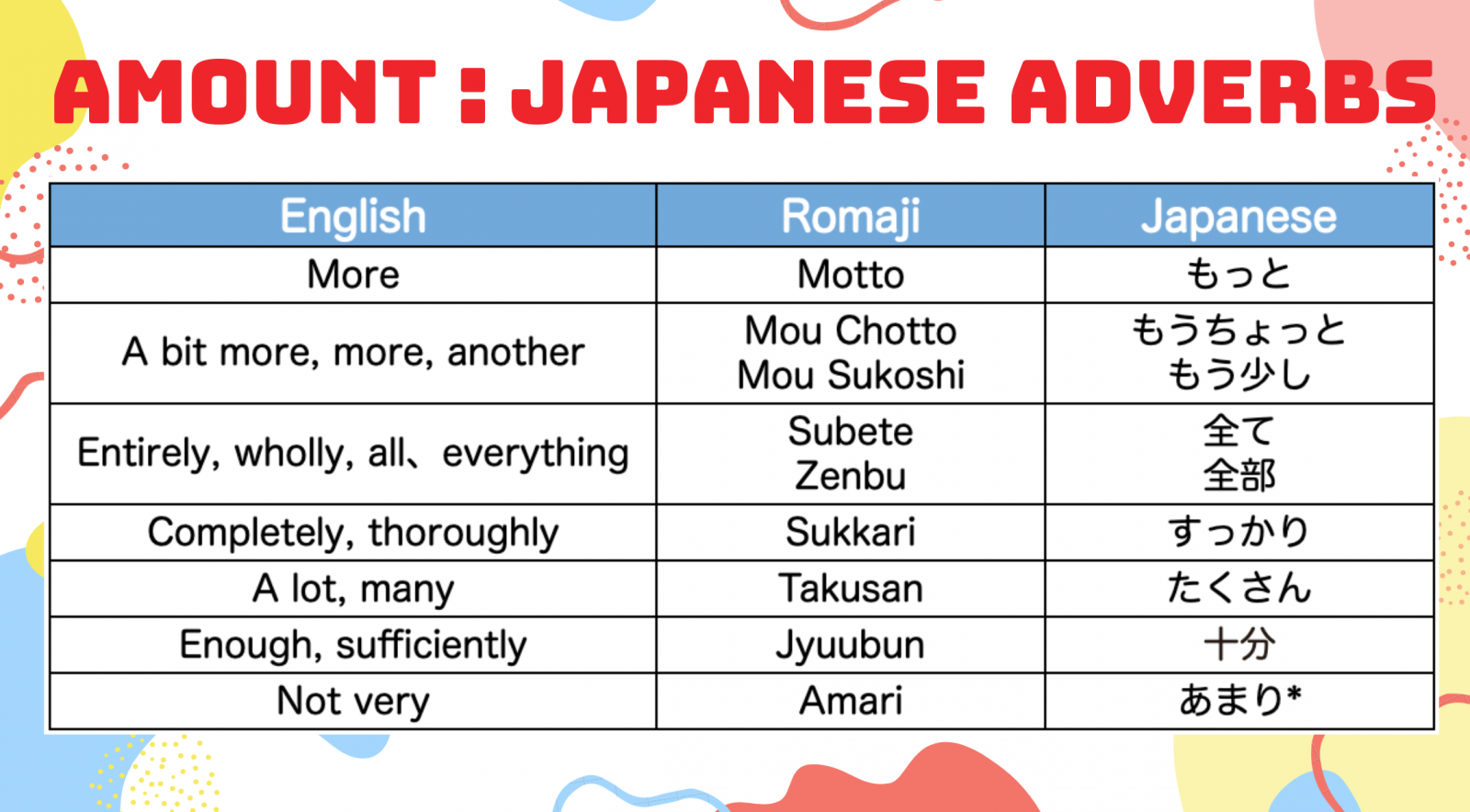
Japanese adverbs (副詞, fukushi) are words that modify verbs, adjectives, and other adverbs. They are similar to English adverbs, but there are some important differences.
Differences between Japanese and English adverbs
- Japanese adverbs are not a separate class of words. They are derived from adjectives by changing the ending.
- Japanese adverbs can be placed anywhere in a sentence before the verb they are modifying.
- Japanese adverbs do not have to be placed at the end of a sentence, as they often are in English.
How to form Japanese adverbs
Most Japanese adverbs are formed by changing the ending of an adjective.
- For i-adjectives, change the -i to -ku.
- For na-adjectives, add -ni to the end.
For example:
Adjective: 速い (hayai, fast)
Adverb: 速く (hayaku, quickly)
Adjective: 静か (shizuka, quiet)
Adverb: 静かに (shizukani, quietly)
There are a few exceptions to this rule. For example, the adjective いい (ii, good) becomes the adverb よく (yoku, well).
Types of Japanese adverbs
Japanese adverbs can be classified into different types, depending on what they are modifying.
- Adverbs of manner: These adverbs modify how something is done.
- Adverbs of place: These adverbs modify where something is done.
- Adverbs of time: These adverbs modify when something is done.
- Adverbs of frequency: These adverbs modify how often something is done.
- Adverbs of degree: These adverbs modify how much something is done.
Examples of Japanese adverbs
Here are some examples of Japanese adverbs, classified by type:
Adverbs of manner:
- 速く (hayaku, quickly)
- 遅く (osoku, slowly)
- 丁寧に (丁寧 ni, carefully)
- 上手く (jouzu ni, skillfully)
- 静かに (shizukani, quietly)
- 大声で (oogoe de, loudly)
Adverbs of place:
- ここに (koko ni, here)
- そこに (soko ni, there)
- あそこに (asoko ni, over there)
- 上に (ue ni, above)
- 下に (shita ni, below)
- 前に (mae ni, in front)
- 後ろに (ushiro ni, behind)
Adverbs of time:
- 今 (ima, now)
- 昨日 (kinou, yesterday)
- 今日 (kyou, today)
- 明日 (ashita, tomorrow)
- いつも (itsumo, always)
- よく (yoku, often)
- たまに (tamani, sometimes)
Adverbs of frequency:
- 一回 (ichikai, once)
- 二回 (nikai, twice)
- 三回 (sankai, three times)
- 何回も (nankai mo, many times)
- 毎日 (maいにち, every day)
- 毎週 (mai-shū, every week)
- 毎月 (mai-tsuki, every month)
Adverbs of degree:
- とても (totemo, very)
- 非常に (hijō ni, extremely)
- 少し (sukoshi, a little)
- ほとんど (hotondo, almost)
- 全然 (zenzen, not at all)
How to use Japanese adverbs
Japanese adverbs are used to modify verbs, adjectives, and other adverbs. They can be placed anywhere in a sentence before the word they are modifying.
For example:
- 彼は速く走った。 (Kare wa hayaku hasitta. He ran quickly.)
- 私は静かに寝た。 (Watashi wa shizukani neta. I slept quietly.)
- 彼はとても賢い。 (Kare wa totemo kasukoi. He is very smart.)
Here are some additional tips for using Japanese adverbs:
- Adverbs of manner can be used to describe how something is done, how someone looks, or how someone feels.
- Adverbs of place can be used to describe where something is or where something
WebIn this article, I'll go over the various aspects of Japanese adverbs, including types of adverbs, how to form them, and perhaps most importantly, how to use them in a. WebJapanese Adverbs. Learning the Japanese Adverbs displayed below is vital to the language. Japanese adverbs are part of speech. Generally they're words that modify any part of. WebCreating adverbs from adjectives. There are many words that are not adverbs by themselves but are made into adverbs from other adjectives. This is similar to how "ly".

The Ultimate Guide To Japanese adverbs - Source: bondlingo.tv

The 100 Most Common Japanese Adverbs & How to Use Them - Source: www.japanesepod101.com

Using Adverbs in Japanese - 80/20 Japanese - Source: 8020japanese.com
What Is Japanese Adverbs, What's different about Japanese adverbs of frequency and infrequency, 3.68 MB, 02:41, 34,237, ToKini Andy, 2022-04-28T04:22:57.000000Z, 2, The Ultimate Guide To Japanese adverbs, 1600 x 884, png, adverbs, 3, what-is-japanese-adverbs
What Is Japanese Adverbs.
Japanese adverbs of frequency and infrequency are a LITTLE different, but quite simple to use when you get the hang of it. In this video, I try to help you understand these Japanese adverbs of frequency.
This grammar point is considered JLPT N5, and is presented in Genki Lesson 3.
Practice this and other grammar points at: tokiniandy.com
DONATE: tokiniandy.com/donate
ToKini Andy MERCH: bit.ly/380JkDc
DISCORD: discord.gg/WP7zYHC
Join this channel to access to perks: bit.ly/2QK6CUc
The Ultimate Guide To Japanese adverbs
What Is Japanese Adverbs, WebJapanese Adverbs. Learning the Japanese Adverbs displayed below is vital to the language. Japanese adverbs are part of speech. Generally they're words that modify any part of. WebCreating adverbs from adjectives. There are many words that are not adverbs by themselves but are made into adverbs from other adjectives. This is similar to how "ly".
What's different about Japanese adverbs of frequency and infrequency

Source: Youtube.com
How to change Adjectives into Adverbial usage of adjective in Japanese (Part1)

Source: Youtube.com

0 Comments